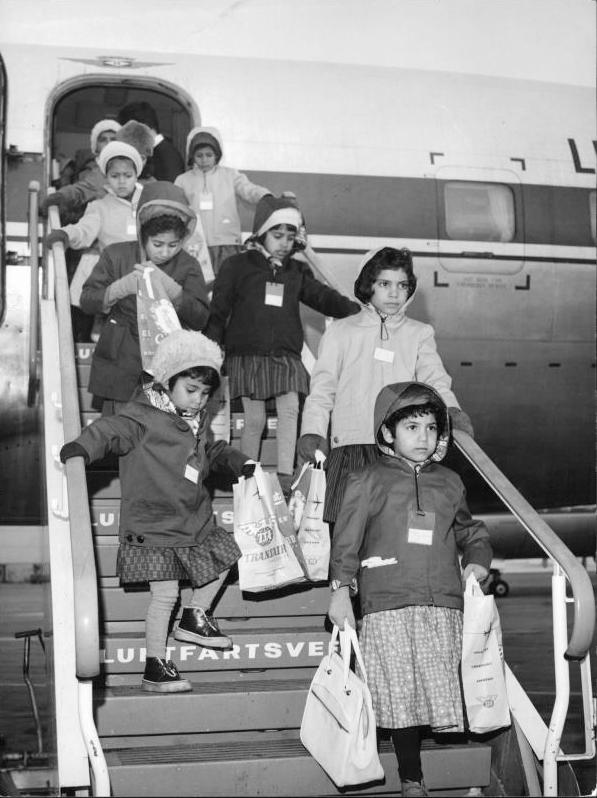
Swedish Humanitarianism

Figure 1.-- Here we see Sweden taking in sick Algerian children in the aftermath of the Algerian Independence War. The photograph is dated March 29, 1963. Notice the warm caps and jackets provided by the Swedes. The press caption read, " Stockholm Med ett chartrat plan från Oran kom på tors- dagskvällen 54 tbc-sjuka barn till Arlanda för vård på svenska sanatorier. Transporten som organise- rats av Rädda barnen är den första i sitt slag. Huttrande i den snåla blåsten samlades småttin- garna i dörren högst upp på flygplanstrappan och beskådade storögt den nya vita värld som öppnade sig framför dem. Det var liksom ingen som riktigt vågade ta mod till sig och ta första steget ner på svensk jord. Så blev trycket bakifrån för stort och hela barnska- ran vällde likt en aldrig sinande ström nerför trap- pan var och en med en gul påse tryckt i famnen." This translates as something like, "A chartered flight from Oran arrived at Stockhom Arlanda Airport on thursday evening with 54 children suffering from TB for care in Swedish sanatoriums. The flight was organized by the Save the Children Foundation. It is the first of its kind. Shivering in the stinging wind the children gathered around the door at the top of the departure steps. They viewed with wide eyes the new white world that opened up before them. It was like no one really mustered the courage to take the first step down on Swedish soil. But the pressure from behind was so great and the whole group gushed like a never-ending stream down. Each of the children carried a yellow Transair yellow bag.
|
|
Swedes see themsleves as a humanitarian nation. They have unquestionably in recent years engaged in humanitarian efforts. The historical record, however, is more mixed than most Swedes would like to admit. This Swedish claim to humanitarianism is based on two pillars: first anti-war policies and second assistnace to the undrprivlidged around the world. As to anti-war policies, it is true that Sweden did not enter either World War I and World War II. But Sweden was not particularly neurtral either. Sweden support the german war economy in both wars. Swedish iron ore was essentially to German steel production. In World War I, Swedish public opinion sided with the Germans which was the agressor nation. This was not the case in World War II, but it is alo true that that the NAZIs could not have waged war without Sweduish iron ore. Now it is true that if they had denined the NAZIs, they wold have been invaded. But that is not the same as speaking from the moral highground. One has to ask oneslve, which is the more humanitarian policy, refuse to go to war and acceot NAZI or Sovie domination or to go to war. What the swedes rarely mention is that if Britaina and Ameica had not gone to war, Sweden and Finland would today be part of either the repressive NAZI or Soviet empire. As to hmanitarianism. The Swedes refused to offer sanctuary to refugee Jews flleing the NAZIs. This only changed in 1943 when the NAZIs moved against the Danish Jews. They did attempt to save Scandanavian Jews at the end of the war with the White busses. After the War Sweden's modern humanitarian efforts began with efforts to assist people first in war-torn Europe and then in developing world as de-colonization unfolded. In recent years they have begun accepting refugees from the Middle East. Pubkic opinion on this have changed, hih\ghligyed by riots broke out in a heavily immigrant suburb of Stockholm (February 2017). The American mainline media mocked President Trump's comments on this, sayin there were no immigrant-related problems in Sweden. Swedish officilas of course began to unsrtatand, reaching the conclusion. Sweden welcomed a historic number of asylum-seekers proportionate to its population. This embarked the country on a vast social experiment that wasn't well thought out and has not gone well. The unrest in the Stockholm suburb of Rinkeby occurred after police made an arrest underscored the problems inherent in Sweden's immigration surge. The violence was beyond the capaciy of officials to hide as they they had been doing in other incidents.
HBC

Related Swedish Pages in the Boys' Historical Web Site
[Return to the Main Swedish page]
[Swedish art]
[Swedish choirs]
[Swedish hairbows]
[Swedish movie page]
[Swedish royalty]
[Swedish schoolwear ]
[Swedish youth groups]
Related Style Pages in the Boys' Historical Web Site
[Long pants suits]
[Knicker suits]
[Short pants suits]
[Socks]
[Eton suits]
[Jacket and trousers]
[Blazer]
[School sandals]
[School smocks]
[Sailor suits]
[Pinafores]
[Long stockings]
Navigate the Boys' Historical Clothing Web Page
[Return to the Main country page]
[Introduction]
[Activities]
[Biographies]
[Chronology]
[Clothing styles]
[Countries]
[Bibliographies]
[Contributions]
[FAQs]
[Glossaries]
[Images]
[Links]
[Registration]
[Tools]
[Boys' Clothing Home]
Created: 2:17 PM 4/18/2019
Last updated: 2:17 PM 4/18/2019



